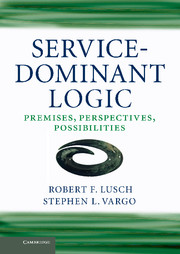9 - Strategic thinking
Published online by Cambridge University Press: 05 June 2014
Summary
The best way to predict the future is to design it.
Buckminster FullerIntroduction
Understandably, when introduced to a somewhat radically different perspective of business, such as service-dominant (S-D) logic, there is a natural tendency to ask: “How can I apply S-D logic to make more money for my firm?” Our response might be disappointing to some: in a truly prescriptive sense, S-D logic cannot be applied, at least directly. This does not mean that there are no normative implications arising from S-D logic. In fact, there are, and they have the potential to provide increased firm viability, including increased profits. They just are neither tactical nor prescriptive but rather strategic and abductive and provided indirectly. As we will discuss, these are provided through the additional insights into what actors can do to shape their destiny and the role and importance of agency that S-D logic offers.
The strategic implications for the application of S-D logic have to do with innovation and market creation, the ongoing (re)creation and institutionalization of value propositions that assist in the value-creation processes of other actors. Thus, S-D logic cannot so much prescribe as it can suggest a perspective for the approach to and the considerations of possibilities. It implies that innovation is achieved through asking the question: “What can I see from an S-D logic perspective that I cannot see from a G-D logic perspective in terms of opportunities for combining and applying available resources to offer value propositions for some other actor?” Arguably, then, the most important endeavor is to step back and examine the landscape.
- Type
- Chapter
- Information
- Service-Dominant LogicPremises, Perspectives, Possibilities, pp. 179 - 200Publisher: Cambridge University PressPrint publication year: 2014

